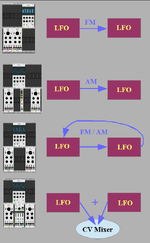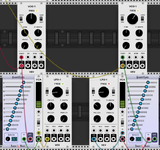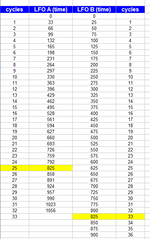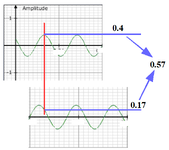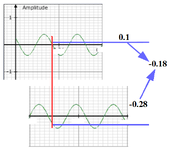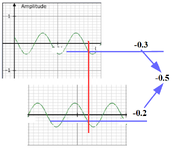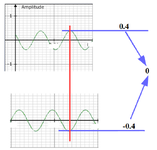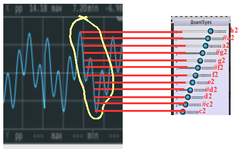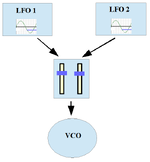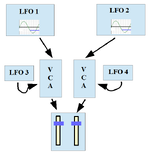After more than 40 years of workingwith modular synths I´ve got the idea of writing down my experiencesand the knowledge that I´ve gained over the years and produce ane-book trilogy about how to make generative music. The first twovolumes are finished, some hundreds of page, legions of videos andpresets, and right now I´m working on volume 3 of the trilogy.
I think that generative music is animportant part of working with modular synths, perhaps one of themost important ones. Therefore I´ve decided to make the main ideasand techniques of my work public – not everyone can afford to buythe books.
I´m going to rework volume 1 into aseries of articles / posts and will even add most of the videodocumentation, and I hope you´ll find my posts interesting andperhaps they will initiate an in-depth discussion of the matter.
And that´s what I´m going to writeabout here (I´ll try to post one article per week):
(more about it all on my websitehttps://dev.rofilm-media.net)
Enjoy your day!
Rolf
Chapter0: About This Course And Some Words About
WhatGenerative Music Is
Chapter1: Real Randomness vs. Complex Cycles
(andthe combination of both)
Chapter1.1: LFOs
Chapter1.2: Other Devices Generating Regular
Cycles
Chapter1.2.1: Looping Envelopes
Chapter1.2.2: Sequencers
Chapter1.2.3: Shift Registers With Feedback
Chapter1.2.4: Sequential Switches
Chapter1.2.5: The Turing Machine – Part 1
Chapter1.2.6: Samples and Recordings
Chapter1.3: Randomness, Probability and
Stochastic
Chapter1.3.1: Some Basic Definitions
Chapter1.3.2: Sample & Hold
Chapter1.3.3: A Short Glimpse at the Turing Machine
Andat Shift Registers Again
Chapter1.3.4: Perfect Pseudo Randomness:
GrayCode Modules
Chapter1.3.5: Imperfect Pseudo Randomness:
EuclideanSequencers
Chapter1.3.6: Random Trigger (Percussion) Sequencers
with Different Amounts of Randomness
Chapter1.3.7: Stochastic Sequencers
Chapter1.3.8: Probability Gates
(RandomClocked Gates)
Chapter1.3.9: Bernoulli Gates
Chapter 2: What to Modulate And to Trigger
Chapter 2.1: Pitch
Chapter 2.2: Timbre
Chapter 2.2.1: Filter
Chapter 2.2.2: Shapers
Chapter 2.2.3: Partials (additive)
Chapter 2.2.4: FM/PM
Chapter 2.3: Voices
Chapter 2.4: Rhythm
Chapter 2.5: Effects
Chapter 2.6: Envelopes
Chapter 2.7: Quantizers
Chapter 2.8: Grains
Chapter 2.9: Sample (Player)
Chapter 2.10: Slew Limiter
Chapter 2.11: Comparators
Chapter 2:12: Pitch Shifter
Chapter 3: Compositional Aspects of Generative Music
Chapter 3.1: General Thoughts, Strategies And
BasicCompositional Decisions
Chapter 3.2: Basic Compositional Techniques
Chapter 3.2.1: Contrasting
Chapter 3.2.2: Repeating, Modifying and
InvertingRelations
Chapter 3.2.3: Basic but Exclusively
GenerativeTechniques
Chapter 3.3: Specific Compositional Techniques
Chapter 3.3.1: Pitch Dependency
Chapter 3.3.2: Rhythm
Chapter 3.3.3: Tension and Layers
Chapter 3.4: Certain Patch Techniques
And Examples
Chapter 3.4.1: Switching Voices and Larger Parts
oft he Patch
Chapter 3.4.2: Sculpture Randomness and
SettingBorders
Chapter3.4.3: Jumping between certain BPM and
Inverting Pitch Lines
Chapter3.4.4: Mixing Stable and Random Elements
Chapter 4: Some Building Blocks of Generative Patching
Chapter 4.1: The Instrumentation of Envelopes
Chapter 4.2: 5 Faces of Randomness
Chapter 4.3: Random Harmonies
I think that generative music is animportant part of working with modular synths, perhaps one of themost important ones. Therefore I´ve decided to make the main ideasand techniques of my work public – not everyone can afford to buythe books.
I´m going to rework volume 1 into aseries of articles / posts and will even add most of the videodocumentation, and I hope you´ll find my posts interesting andperhaps they will initiate an in-depth discussion of the matter.
And that´s what I´m going to writeabout here (I´ll try to post one article per week):
(more about it all on my websitehttps://dev.rofilm-media.net)
Enjoy your day!
Rolf
Chapter0: About This Course And Some Words About
WhatGenerative Music Is
Chapter1: Real Randomness vs. Complex Cycles
(andthe combination of both)
Chapter1.1: LFOs
Chapter1.2: Other Devices Generating Regular
Cycles
Chapter1.2.1: Looping Envelopes
Chapter1.2.2: Sequencers
Chapter1.2.3: Shift Registers With Feedback
Chapter1.2.4: Sequential Switches
Chapter1.2.5: The Turing Machine – Part 1
Chapter1.2.6: Samples and Recordings
Chapter1.3: Randomness, Probability and
Stochastic
Chapter1.3.1: Some Basic Definitions
Chapter1.3.2: Sample & Hold
Chapter1.3.3: A Short Glimpse at the Turing Machine
Andat Shift Registers Again
Chapter1.3.4: Perfect Pseudo Randomness:
GrayCode Modules
Chapter1.3.5: Imperfect Pseudo Randomness:
EuclideanSequencers
Chapter1.3.6: Random Trigger (Percussion) Sequencers
with Different Amounts of Randomness
Chapter1.3.7: Stochastic Sequencers
Chapter1.3.8: Probability Gates
(RandomClocked Gates)
Chapter1.3.9: Bernoulli Gates
Chapter 2: What to Modulate And to Trigger
Chapter 2.1: Pitch
Chapter 2.2: Timbre
Chapter 2.2.1: Filter
Chapter 2.2.2: Shapers
Chapter 2.2.3: Partials (additive)
Chapter 2.2.4: FM/PM
Chapter 2.3: Voices
Chapter 2.4: Rhythm
Chapter 2.5: Effects
Chapter 2.6: Envelopes
Chapter 2.7: Quantizers
Chapter 2.8: Grains
Chapter 2.9: Sample (Player)
Chapter 2.10: Slew Limiter
Chapter 2.11: Comparators
Chapter 2:12: Pitch Shifter
Chapter 3: Compositional Aspects of Generative Music
Chapter 3.1: General Thoughts, Strategies And
BasicCompositional Decisions
Chapter 3.2: Basic Compositional Techniques
Chapter 3.2.1: Contrasting
Chapter 3.2.2: Repeating, Modifying and
InvertingRelations
Chapter 3.2.3: Basic but Exclusively
GenerativeTechniques
Chapter 3.3: Specific Compositional Techniques
Chapter 3.3.1: Pitch Dependency
Chapter 3.3.2: Rhythm
Chapter 3.3.3: Tension and Layers
Chapter 3.4: Certain Patch Techniques
And Examples
Chapter 3.4.1: Switching Voices and Larger Parts
oft he Patch
Chapter 3.4.2: Sculpture Randomness and
SettingBorders
Chapter3.4.3: Jumping between certain BPM and
Inverting Pitch Lines
Chapter3.4.4: Mixing Stable and Random Elements
Chapter 4: Some Building Blocks of Generative Patching
Chapter 4.1: The Instrumentation of Envelopes
Chapter 4.2: 5 Faces of Randomness
Chapter 4.3: Random Harmonies

